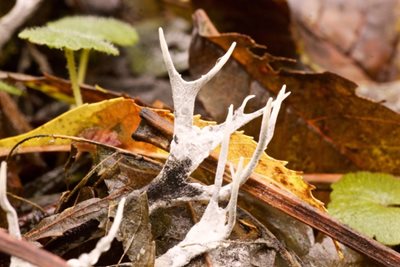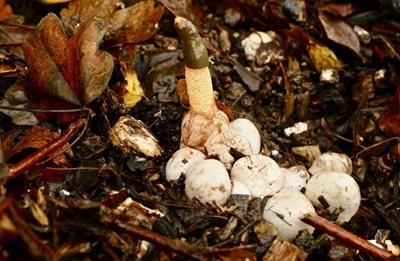A guest blog following our Broadland Group event at NWT Pigneys Wood.
Our annual autumn fungus walk at one of Norfolk Wildlife Trust”s latest reserves, Pigney’s Wood, a mile or so outside North Walsham benefited from an enthusiastic group and very benign weather. There were so many types of mushroom in the woods near to the car park that we were never very far from our vehicles.
In 1993 Pigneys Wood was purchased by the North Norfolk Community Woodland Trust (NNCWT) which was a community based conservation charity. NNCWT successfully reverted the site from arable land to mixed woodland by planting over 20,000 trees of 40 different species during this time as well as restoring important wetland areas and improving the access and interpretation of the site for local people by providing guided trails.In September 2017, Pigneys Wood was entrusted to Norfolk Wildlife Trust to continue the conservation management.

Candlesnuff fungi
The woodland close to the car park contains a mixture of coniferous and deciduous trees and plenty of dead and decaying wood and woody debris, an ideal habitat for fungi to thrive as they are essential to the breakdown of dead wood and returning elements to the woodland environment.
As soon as the event started everyone in the group scattered and started to bring in specimens on bits of wood or pointed out examples that they had found on the woodland floor. For example a group of Dog Stinkhorns were found on the ground close by in various stages from the “egg” they sprout from to the mature fruiting body. Also groups of Clouded Funnels, Common Funnels and Wrinkled Clubs were discovered around the bases of the trees. On a fallen pine cone there were a number of small Conifer Cone Caps which were sprouting from between the scales and on many dead twigs there were oysterlings, which are small fungi with white caps and gills which project from the wood with no stems.
Among the more notable discoveries was the aptly named Herald of Winter which has a greasy olive brown cap and yellowish cap and stem which is fairly uncommon and only grows with pines trees in the autumn. There were also lots of types Bonnet fungus, which are fairly common in woodland. These have white gills and grow on dead wood or the soil under trees. We found Angel Bonnet, Coldfoot Bonnet, Snapping Bonnet, Iodine Bonnet, Nitrous Bonnet and Frosty Bonnet.

Dog stinkhorn
Some very small specimens, which required the use of the hand lens to appreciate the intricate structure of the fungi, were also discovered. These included Lemon Disco - extremely small, vivid yellow discs which were growing on a little bramble twig, and Collared Parachutes which are tiny mushrooms with dark wiry stems and a cap that resembles a parachute and a collar like an Elizabethan ruff joining it to the stem.
Altogether we found 55 species from some interesting groups - Roundheads, Cavaliers and Knights! - all within a 100 yards of the carpark so we didn’t have far to walk back to the cars ! A very enjoyable morning.
Footnote from the Chair - The Broadland Group would like to thank Steve Pinnington and Yvonne Mynett for leading another successful Fungi foray and for the participants who kindly donated £60 for Trust funds.
Header image: Frosty Bonnet (Mycena tenerrima) at Damgate Wood